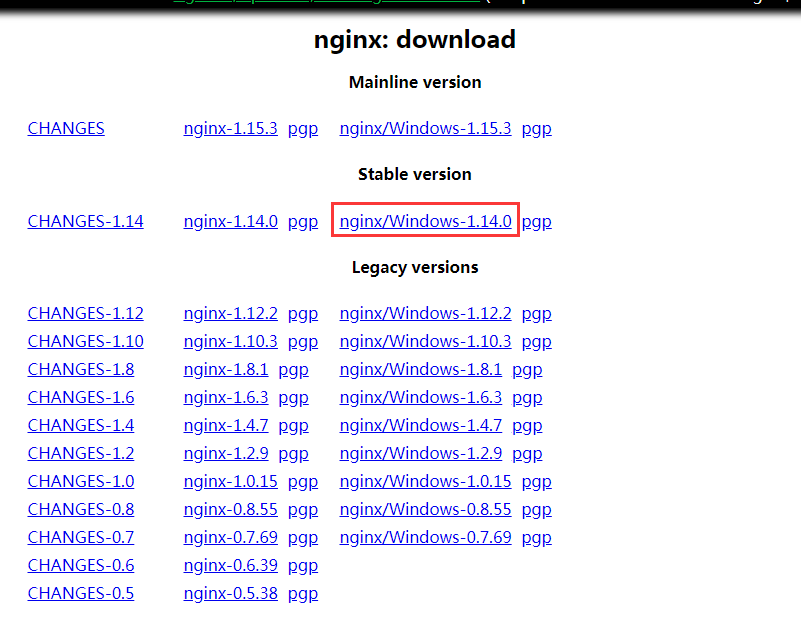1.下载并安装nginx
到nginx官网上下载相应的安装包,http://nginx.org/en/download.html;

下载之后进行解压,将解压后的文件放到自己心仪的目录下,如下图所示:

至此,下载和安装nginx就已经完成了。
2.启动nginx
打开cmd命令窗口,切换到nginx解压目录下,输入命令 start nginx ,回车即可,此时可能会有一个黑色的弹窗一闪而过,不用理会。
打开浏览器,输入网址 http://localhost:80;回车,如果出现以下页面说明启动成功:

3.nginx常用命令
| 命令 | 描述 |
|---|---|
| nginx -h | 查看nginx帮助 |
| nginx -v | 查看nginx版本 |
| nginx -t | 测试nginx配置 |
| nginx -T | 测试nginx帮助,并打印配置信息 |
| nginx -s reload | 重新加载配置文件,平滑启动nginx |
| nginx -s stop | 快速停止nginx |
| nginx -s quit | 完整有序的停止nginx |
4.nginx基本配置
nginx的配置文件在nginx解压目录/conf/nginx.conf,用编辑器打开即可进行相关配置
#user nobody; # 设置nginx服务的系统使用用户
worker_processes 1; # 工作进程数
#error_log logs/error.log; # nginx错误日志
#error_log logs/error.log notice;
#error_log logs/error.log info;
#pid logs/nginx.pid; # nginx服务启动时候的pid
events {
worker_connections 1024; # 每个进程允许最大连接数
}
http {
include mime.types;
default_type application/octet-stream;
# access_log日志展示格式
# $remote_addr:客户端地址
# $remote_user:客户端请求nginx认证的用户名,默认不开启认证模块,没有记录
# $time_local: 客户端请求的时间
# $request:客户端请求的请求头
# $status: 请求的状态码
# $body_bytes_sent: 服务端相应客户端body信息的大小
# $http_referer: 访问当前页面的上一级页面地址
# $http_user_agent: 客户端浏览器的agent
# $http_x_forwarded_for:请求所携带的http信息
log_format main '$remote_addr - $remote_user [$time_local] "$request" '
'$status $body_bytes_sent "$http_referer" '
'"$http_user_agent" "$http_x_forwarded_for"';
access_log logs/access.log main;
sendfile on;
#tcp_nopush on;
#keepalive_timeout 0;
keepalive_timeout 65; # 连接超时时间
#gzip on;
server {
listen 80; # 监听前端打开的80端口
server_name localhost; # 代理前端访问的地址
charset utf-8;
#access_log logs/host.access.log main;
location / {
root html; # 需要代理的前端页面代码目录(包含index.html等文件的目录)
index index.html index.htm;
}
location /test/ {
proxy_pass http://127.0.0.1:8000/test/; # 将前端的/test/请求转发到后端哪个地址
proxy_set_header Host $host;
proxy_set_header X-Real-IP $remote_addr;
proxy_set_header X-Forwarded-For $proxy_add_x_forwarded_for;
}
# 静态资源文件
location /files/ {
root F:/nginx-1.12.2/nginx-1.12.2/;
autoindex on;
}
#error_page 404 /404.html;
# redirect server error pages to the static page /50x.html
#
error_page 500 502 503 504 /50x.html;
location = /50x.html {
root html;
}
# proxy the PHP scripts to Apache listening on 127.0.0.1:80
#
#location ~ .php$ {
# proxy_pass http://127.0.0.1;
#}
# pass the PHP scripts to FastCGI server listening on 127.0.0.1:9000
#
#location ~ .php$ {
# root html;
# fastcgi_pass 127.0.0.1:9000;
# fastcgi_index index.php;
# fastcgi_param SCRIPT_FILENAME /scripts$fastcgi_script_name;
# include fastcgi_params;
#}
# deny access to .htaccess files, if Apache's document root
# concurs with nginx's one
#
#location ~ /.ht {
# deny all;
#}
}
# another virtual host using mix of IP-, name-, and port-based configuration
#
#server {
# listen 8000;
# listen somename:8080;
# server_name somename alias another.alias;
# location / {
# root html;
# index index.html index.htm;
# }
#}
# HTTPS server
#
#server {
# listen 443 ssl;
# server_name localhost;
# ssl_certificate cert.pem;
# ssl_certificate_key cert.key;
# ssl_session_cache shared:SSL:1m;
# ssl_session_timeout 5m;
# ssl_ciphers HIGH:!aNULL:!MD5;
# ssl_prefer_server_ciphers on;
# location / {
# root html;
# index index.html index.htm;
# }
#}
}
(完)